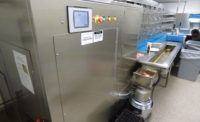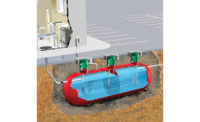This past April I was privileged to serve as a member of the ICC Plumbing Code Change Committee during the ICC Committee Action Hearings in Memphis, Tenn.
As you may be aware, the primary responsibilities of serving on the committee include reviewing proposed changes to the next version of the IPC, listening to testimony on the proposals and then deciding by vote whether proposals should be approved, modified or disapproved.
Two proposals were submitted on food-waste disposal units (FWD). Both intended to change the code language and prevent FWDs from discharging through a grease interceptor.
The IPC currently requires a FWD to be routed through a grease interceptor and it protects the grease interceptor from excessive accumulation of food particles by requiring a solids interceptor between the grease interceptor and the FWD.
Proponents of routing a FWD directly to the sanitary argue against the use of a solids interceptor, focusing on the maintenance required by a food service establishment (FSE) to empty the solids interceptor. It is argued that solid interceptors have to be emptied daily or multiple times a day and FSEs simply will not do it.
A lack of proper maintenance of solids interceptors by FSEs is not a valid reason to route a FWD directly to sanitary. Frequent maintenance of a solids interceptor can be reduced by installing a larger unit, reducing or eliminating the use of the FWD, or instilling better kitchen practices to not allow food solids to go down the drain.
Playing catch
Another argument suggests capturing the discharge from a FWD in a solids interceptor undermines the purpose of having a FWD. The question boils down to how food waste should be handled in a FSE.
The choices include directly sending the food waste to the sanitary collection system by means of a FWD, or any number of alternatives which include:
- Low-tech onsite composting;
- Waste disposal to landfill/composting/waste to energy; or
- More modern technologies such as non-biological onsite treatment systems, in-vessel dry composters or biological liquefaction (wet systems).
When making a choice as to how food waste will be handled at a particular FSE, one of the points to consider is whether the effluent from a FWD contains appreciable amounts of fats, oils and grease (FOG), warranting a requirement for the waste to be routed through a grease interceptor. To answer that, we can look at several studies.
The New York City Department of Environmental Protection published a study titled “Commercial Food Waste Disposal Study” in December 2008. The purpose of the study was to evaluate “the costs and benefits of allowing the use of commercial food waste disposers in New York City.”
The study concludes the costs and risks associated with allowing the use of commercial FWDs in New York was not sustainable for a variety of reasons including: “While it is illegal to discharge fats, oil and grease into the sewer system, FOG is still a cause of sewer backups. Due to the high fat content of food waste, use of FWDs would discharge substantial amounts of FOG to the sewer system, which could lead to more sewer backups and maintenance needs.”
The fat content of the food was assessed from 172 samples taken from universities, medical facilities, grocery stores, restaurants and hotels, as well as other FSEs such as caterers, shelters, nonpublic schools and senior centers. The samples were sent to City College of New York where they were subjected to FWD grinding and then analyzed for chemical composition. See Table 1 for a summary of the relevant data.
The header in Table 1 “1664 Oil and Grease” refers to EPA test method 1664A, which determines FOG concentration levels in a grab sample. Using grams per kilogram (g/kg) is not the typical way FOG concentrations are reported so I converted them to milligrams per liter (mg/L). The conversions are close enough for our purposes.
To put these numbers into perspective consider that the majority of pretreatment programs around the country allow a maximum FOG concentration discharge of only 100 mg/L. The FOG concentration discharges recorded from these samples are extremely high, supporting the conclusion that food waste from FSEs does in fact have a “high fat content.”
The 2008 “ASPE Plumbing Engineering Design Handbook – Volume 4” makes the following statement, “It is recommended that food waste disposers be connected to HGIs and GRDs (in conjunction with a solids strainer) when allowed by the authority having jurisdiction due to the fact that disposer waste discharge is a prime carrier of FOG-laden material (emphasis added).”
As recent as May 2013, ASPE offered a continuing education course titled “Grease Interceptors CEU 199,” in which it makes the same recommendation to connect FWDs to HGIs and GRDs in conjunction with a solids strainer and for the same reason, “disposer waste discharge is a prime carrier of FOG-laden material.”
Eliminate garbage disposals?
According to the EPA’s 2002 “Onsite Wastewater Treatment Systems Manual,” eliminating the use of garbage disposals can significantly reduce the amount of grease, suspended solids and BOD in wastewater,” the manual stated. Table 15 in the manual shows a potential reduction in fats, oils and grease of 60 to 70% for residential installations. We would expect significantly higher reductions from commercial FSEs that forgo the use of a FWD.
There appears to be widespread agreement that food waste is a source of high concentrations of FOG, and since a FWD is not capable of removing FOG from food waste, it simply does not make sense to route a FWD directly to sanitary.
Proponents of discharging FWDs directly to sanitary also argue the food waste from these devices does not contribute to FOG deposit formation. The problem with that argument is they focus on the food waste and not the FOG contained within the food waste.
According to a study titled “Properties Influencing Fat, Oil and Grease Deposit Formation,” by Keener, Ducost and Holt published in December 2008: “The physical properties and visual characteristics [of FOG deposits] suggest the majority of deposits (84%) are metallic salts of fatty acids formed by saponification.”
Nowhere does the research indicate food particles themselves are aiding in the formation of FOG deposits, but rather FOG in the collection system, including FOG contained in food waste, is the problem. No matter how small a FWD grinds up food particles it simply cannot remove the FOG contained in the food waste.
A FWD should be routed through a grease interceptor because it is necessary to separate the FOG contained in the discharge. A solids interceptor should be installed upstream of the grease interceptor in order to prevent food waste from filling up the grease interceptor, which everyone agrees is bad for the performance of the grease interceptor.
Now you can understand why I don’t think the IPC needs a revision that would route the discharge from a FWD directly to the sanitary. Of course, you get to draw your own conclusion.
Should we eliminate garbage disposals? Let us know your thoughts in the Comments section below. We’d love to hear from you!
Author bio: Ken Loucks is the regulatory compliance manager for Schier Products Co., and has worked in the plumbing industry since 1989. He is responsible for working with wastewater authorities on pretreatment program development and improvement, is an alternate member of ASME A112.14.3 project team and is a member of the ICC Plumbing Code Change Committee for the 2015-2017 cycle. He can be reached by email at ken.loucks@schierproducts.com.




